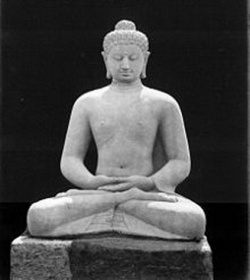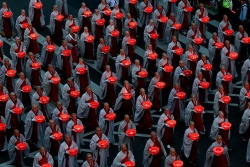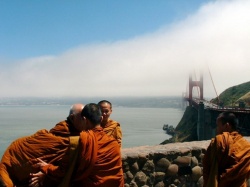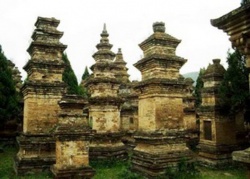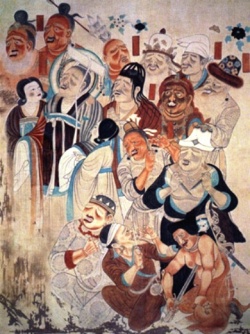The Decline of the Dharma in Early Chinese Buddhism
- Randall L. Nadeau [1}
- originally published in B. C. Asian Review volume 1, 1987
The Scripture Preached by the Buddha on the Total Extinction of the Dharma is one of the earliest of a large body of Chinese Buddhist texts describing the degeneration of the Buddha's teaching due to moral laxity and depravity within the religious community. Most of these works place the end of the Dharrna (mo-fa, Japanese mappô ) in the context of radical world-transformation, heralded by the future Buddha, Maitreya, or other harbingers of the golden age to come. Mo-fa is a central motif of the major doctrinal schools of the Sui and Tang, and reappears in sectarian religious literature from the Ming to the present. Perhaps more than any other theme, the "decline of the Dharma" has fired the imagination of prophets and visionaries throughout the history of Chinese Buddhism.
The text which appears in translation below is the only one extant among works with similar titles listed in the earliest Buddhist catalogs. Seng-you cited it in the Chu San-zang Ji Ji (2) — composed in 515 A.D. — and copied it almost in its entirety into his Shi-jia Pu (3). A Sui catalog of 594 A.D. was the first to describe the work as a "spurious scripture" (wei-jing ) — a designation almost certain to be accurate (4). The setting of this "sutra" on the eve of Sakyamuni's pari-nirvana, the general theme of moral and religious degeneration, the roles played in the text by Candraprabha and Maitreya, as well as the absence of a Sanskrit or Pali original, all indicate that the work is a product of the Chinese Buddhist community (5).
The Scripture Preached by the Buddha on the Total Extinction of the Dharma reports the Buddha Sakyamuni's prediction that his Dharma will be transgressed and desecrated by evil demons (mara) posing as monks and nuns. In addition to breaking every precept of the monastic code, these mara-monks devote themselves to secular self-gratification, drive away saints and holy men, and are devoid of all compassion. The Sangha becomes a refuge for slaves and criminals, and society at large is plagued by corruption, immorality, and bitter suffering. Even the natural world is out of balance: rains are untimely, the grain does not ripen, and pestilential vapors spread everywhere. After many years of cosmic decline, the bodhisattva Candraprabha will appear, and then all twelve divisions of the Tripitaka will also be extinguished. But our scripture closes with a vision of hope. Tens of thousands of years in the future, Maitreya will usher in a golden age of infinite blessing and goodness: a new world order in which the Dharma at last may be realized.
Why would a text such as the Scripture Preached by the Buddha on the Total Extinction of the Dharma have been written? It is the degeneration of the religious Order that is said to initiate the decline of the Dharma, and our investigation of the author's motivations for composing the work should begin with his implicit attack on the Sangha. Let us explore briefly four possibilities: 1) the author was faithfully transmitting the doctrine of the end of the Dharma as it appears in Indian Buddhism; 2) the text is a factual description of the Chinese religious community as the author perceived it in the fifth century; 3) the author was motivated by sectarian concerns to attack the established church; 4) the negative characterization of the Sangha is secondary to the vision of hope and transformation described in the final paragraphs of the text. Arguments can be made for each of these premises.
1) The doctrine of mo-fa in Indian Buddhism. In the Pali Canon, there are several dialogues which describe a future golden age, to be ruled by a messianic king named Cakkavatti (Sanskrit: Cakravarti), the Great Wheel-Turner. According to these texts, Cakkavatti will reign after the completion of an immense cycle of decline and renewal. In the first-century A.D. Cakkavatti-Sihanda Suttanta (6), for example, the Buddha states that we are now in the downward phase of a macrocosmic cycle, the nadir of which will see the destruction of the Buddhist Dharma. Various portents of decline are visible in the present age, including negligence in the observation of the precepts, moral pollution of the Sangha by secular values, and social and political conditions unfavorable for the perpetuation of the faith (7).
While precedents for the mo-fa doctrine exist in the Pali sutras, the theme receives its fullest articulation and development in Chinese Buddhist apocrypha. Early Chinese messianism — "Taoist" as well as "Buddhist" — describes the degeneration of the present world in terms of a future apocalypse, and emphasizes the imminence and transformative power of the eschaton (8). The Pali references are infrequent, and descriptively pale by comparison.
2) The medieval Chinese Sangha. Another possible motivation for the composition of the Scripture Preached by the Buddha on the Total Extinction of the Dharma is distress over the state of the religious Order in the fourth and fifth centuries. There is a broad range of evidence for moral laxity and improper behavior within the Chinese Buddhist community of the time, and the author of our text may have been seeking a cosmological explanation for what he perceived to be the real and tangible deterioration of monastic practice. Contemporary official documents criticize the Order for the very conditions described in the Scripture Preached by the Buddha on the Total Extinction of the Dharma: improper motivation for entering the clergy (to escape taxes, military service, criminal prosecution, or slavery), blatant disregard for the precepts and ordinances, and involvement in secular activities for profit and advancement (9). Buddhist leaders themselves admitted the severity of the crisis: Hui-yuan wrote in the early fifth century, "It is already a long time since the Buddhist doctrine has become degenerate and mixed with impure elements." (10) Arguments by the apologist Mou-zi also imply an admission of the problem, as he defended the faith despite the abuses of disreputable clerics (11).
Clearly, there was enough backsliding and lassitude within the Order to elicit criticism both from without and from within. Comparing themselves to models of discipleship and observance in the distant past, or to an idealized Sangha, it is little wonder that early medieval Chinese Buddhists saw their community in a process of decline and dissolution. In one indigenous scripture, the Buddha announces, "Those who destroy my teaching are in fact my own disciples, no one else." (12) Similarly, the Scripture Preached by the Buddha on the Total Extinction of the Dharma may represent a religious response to a very real crisis within the Order.
3) The Doctrine of Decline in Chinese Sectarianism. The text translated below predates the development of the major schools of Chinese Buddhism, but it may have been the product of one of the many critics of orthodoxy within the Chinese Buddhist community of the period. The Tian-tai, Pure Land, Chan, and upstart Three Stages schools all were critical of the clergy, and some broke away to establish cloisters or retreats of their own. The doctrine of the decline of the Dharma is central to the teachings of each of these schools (13). Some quote directly from the earlier mo-fa sutras, such as the Scripture Preached by the Buddha on the Total Extinction of the Dharma (14). Whether or not abuses within the Order were as widespread as I have suggested above, the "attack on the establishment" was characteristic of the Sui and Tang schools. If we can draw a connection between our text and the emergence of these sects in the following century, then the implicit criticism of the Buddhist community in the Scripture Preached by the Buddha on the Total Extinction of the Dharma may be viewed as an early expression of anti-clericalism as it comes to be articulated in sectarian scriptures and commentaries. The explicit goal of these schools — and the heterodox sects of later Chinese Buddhism — was to replace the old, established order with a new community, composed of clergy and laity alike, dedicated to the realization of Mahayana ideals by means of a new understanding of the Dharma, the practice of meditation, or piety and reverence. Criticism of the existing religious community was part of the sectarian programme, and not necessarily a reflection of actual conditions. We may speculate that the Scripture Preached by the Buddha on the Total Extinction of the Dharma is an early expression of the prophetic voice in medieval Chinese sectarianism.
4) Maitreya and the Golden Age of the Future. Cults of the Buddha Maitreya existed in the early Chinese church. These cults described Maitreya, dwelling in the Tusita paradise, as an object of veneration much like Amitabha for the Pure Land School. Our text is perhaps the first to associate Maitreya with the mo-fa doctrine and a vision of eschatological salvation. In the heterodox sectarian movements of late imperial China, Maitreya is described as both savior and regent, delivering the faithful from the corruption and suffering of the present world and ruling over the golden age to come. The Scripture Preached by the Buddha on the Total Extinction of the Dharma places this time of cosmic transformation in the far-distant future (as do all the earliest mo-fa scriptures), but later sectarians described Maitreya's descent as imminent. Their condemnation of the existing religious and social order, coupled with their announcement that the eschaton was near at hand, contributed to swift and often cruel persecution by imperial authorities.
If we focus on the last paragraphs of the text, describing a golden age of the future initiated by the compassionate saviour Maitreya, then the earlier criticism of the Sangha could be regarded as a prelude to the central visionary message of the work. Faith and hope are fuelled by hardship or disappointment, and the description of moral decline may principally be a device used to inspire faith. However, this faith could not have had the same immediacy and emotional depth as that enlivened by later Maitreya scriptures, which announce the imminent destruction and transformation of the present world order. Still, the Scripture Preached by the Buddha on the Total Extinction of the Dharma is one of the roots of Maitreyan eschatology, which was to play so prominent a role in the history of Chinese Buddhism. It is likely that all of the factors listed above contributed to the composition of the Scripture Preached by the Buddha on the Total Extinction of the Dharma. Indian precedents exist for the mo-fa theme; the medieval Chinese Sangha was in disrepute; sectarian attacks on the established order were soon to be heard; and Maitreyan eschatology was to dominate Chinese popular religion. The work is the earliest of its kind in our possession, and a marvellous example of popular Buddhist cosmology.
The Scripture Preached by the Buddha on the Total Extinction of the Dharma
(In Seng-you's catalog [15] it has no translator's name; it is now attached to the Song Catalog [16].)
Thus I have heard. Once, the Buddha was in the state of Kushinagara (17); he was to attain Parinirvana in three months. Together with all the monks and all the bodhisattvas, an innumurable crowd came to visit the place where the Buddha was, and bowed themselves to the earth. The World-Honored One was still, silent and preaching nothing; his radiant brilliance was not manifested.
The wise and wordly Ananda did obeisance, and said to the Buddha, "World-Honored One, whenever you have preached the Dharma, your majestic brilliance has been uniquely illustrious. But now, a great multitude has come together, and your radiance is not manifested in the slightest. What is the reason for this? A reason there certainly must be, and we wish to be taught its significance."
The Buddha was silent, and made no response. After Ananda had repeated the question three times, the Buddha told him, "After my nirvana, the Five Mortal Sins (18) will foul the world, and the Mara-way will flourish exceedingly. The Maras will become monks, to spoil and wreck my Way. They will wear lay dress (rejoicing in cassocks] (19) and multicolored clothing. They will drink wine and eat meat, killing living things in their desire for fine flavors. They will not have compassionate minds, and will hate and envy each other.
"At times, there will be Bodhisattvas, Pratyeka-buddhas, and Arhats, who concentrate single-mindedly on cultivating merit and treat all beings with reverence; being the objects of the people's devotion, they will impartially preach and convert. They will pity the poor and keep the old in their thoughts, and take care of those in poverty and difficulty. They will constantly induce the people to worship and serve scriptures and images, doing all good acts that bring merit; their wills and natures will be kind and good (20). They will not harass or injure people, but sacrifice themselves for the deliverance of others. They will not spare themselves, but will put up with insult, being benevolent and harmonious. "Should there be such a being, the gang of Mara-monks will unite in hating him, slandering him and focusing on his bad points. He will be expelled and banished; they will not suffer him to remain. From then onwards [?] (21) they will all fail to cultivate merit according to the Way. Temples will be empty and desolate, and will no longer be repaired, but will be allowed to fall into ruin. The monks will covet nothing but material goods, accumulating them without distribution, not doing good deeds. They will deal in male and female slaves, plough the fields and plant them, burning off the mountain forests and harming all living things; they will not have compassionate minds. Male slaves will become monks, female slaves will become nuns; they will have none of the merit that comes from practicing the Way, but rather will be filthy and depraved, foul and turbulent; men and women will not be kept separate. The reason the Way will become shallow and weak, is all because of that type of person!
"Some will evade the constables by taking refuge in (22) my Way, seeking to become monks, but not practicing the precepts and ordinances. At the middle and end of the lunar month, although in name they should chant the precepts, they will be tired of it and resentful; lazy and careless, they will not wish to listen. They will select and abbreviate here and there, unwilling to speak everything. The scriptures will not be recited, and should there be readers, they will not know the characters and phrases; they will force interpretations and allege their accuracy, not bothering to ask people who know. In their haughtiness they will pursue fame, making a vain display of elegant manners with which to glorify themselves, and hope for people's offerings.
"This gang of Mara-monks will be doomed to fall spirit and soul into Avici Hell (23) after the end of their fated lives. In their punishment for the Five Mortal Sins, there is nothing they will not suffer as hungry ghosts and domestic animals, for as many kalpa as there are grains of sand in the Ganges. Their sin atoned for, only then will they come forth, but they will be born in a frontier state, where there will be no place that has the Three Treasures (24).
"When the Dharma is on the verge of being destroyed, it is women who will concentrate on advancement, and have the habit of performing good deeds. Men will be lazy and indolent; they will have no use for the words of the Dharma. They will consider monks to be like befouled earth; they will not have believing minds.
"The Dharma is about to be wiped out, and when the time for that comes, all the Devas will weep tears. Rainy and dry seasons will be untimely, the Five Grains will not ripen, pestilential vapours will be prevalent; there will be many dead. The common people will toil in hardship, the public officials will be calculating and harsh; not compliant with the principles of the Way, all will have their hearts set on pleasure or disorder. Wicked men will steadily increase in number, to become like the sands of the sea; the good will be very scarce, no more than one or two. "Because the kalpa is nearly at its end, the days and months will become shorter and shorter, and men's lives will pass more and more hastily; their heads will be white at forty. Men will be filthy and depraved; they will exhaust their semen (25) and shorten their lives, living at most to the age of sixty. The lives of men will become shorter, but the lives of women will become longer, to seventy or eighty or ninety; some will reach a hundred years.
"Great floods will suddenly occur; they will strike by surprise, unlooked-for. The people of the world will have no faith, and hence they will take the world to be permanent (26). Living creatures of every variety, with no distinction between gentry and the base, will be drowned and float away, dashed about, to be eaten by fish or turtles.
"At that time, there will be Bodhisattvas, Pratyeka-Buddhas, and Arhats; the gang of Maras will drive them away, and they will not participate in the religious community. These three types of disciples will enter into the mountains, to a land of merit. Tranquil and self-controlled, they will rest content in this. Their lives will grow longer, the various Devas will protect and watch over them, and Candraprabha (27) will appear in the world. They will be able to meet him, and together they will make my Way flourish.
"In fifty-two years after that, the Sûramgama Scripture (28) and the pratyutpanna-samâdhi (29) will prematurely change and vanish, and shortly afterwards the twelve divisions of the Mahayana canon will also be destroyed in their entirety, and will not appear again. The robes of the monks will spontaneously turn white (30).
"When my Dharma is destroyed, the process will be comparable to an oil lamp, which, drawing close to the time it will go out, will shed an even greater radiance and brilliance, and then be extinguished. When my Dharma is destroyed, it will surely be like a lamp going out. "What will happen then is not possible to describe in detail. But several thousand myriad years after this happens, Maitreya will descend to be Buddha in the world. All-under-Heaven will enjoy peace, prosperity, and equality; the pestilential vapours will be dispersed and expelled. The rain will be suitable to growth and no more, and the Five Grains will grow and flourish. Trees will grow large, and men will be eighty feet tall. All of them will live eighty-four thousand years. It is impossible to count how many living things will be able to be saved."
The wise and worthy Ananda made obeisance and said to the Buddha, "What shall we name this scripture? How is it to be venerated and practiced?"
The Buddha said to Ananda, "The name of this scripture is The Total Extinction of the Dharma. Propagate it to all; you should cause all to have a clear, complete understanding of it. The merits of its accomplishments are limitless, and cannot be counted up."
The four types of disciple (31) heard the scripture; grief-stricken and rueful, all vowed to attain the Way of the Limitlessly High Sage Truth. All did obeisance to the Buddha, and departed.
NOTES
1) The text of the introduction is by Randall Nadeau; the translation itself was a collective effort of a University of British Columbia Asian Studies 430 (Readings in Chinese Religious Texts) class, winter 1986, taught by Dr. Daniel Overmyer. The membcrs of the class were Randall Nadeau, Gary Arbuckle, Wing Sang Wong, Wai-fan Szeto, and Marcia Ellis. For the notes marked (H) we are indebted to the advice of the referee for the translation, Dr. Leon Hurvitz; any remaining errors are our own responsibility.
2) T.2145, volume 55, p. 28c.
3) T.2040, volume 50, pps. 83c-84b.
4 ) "Spurious" or "apocryphal" scriptures are Chinese indigenous works, despite their claims to be direct translations of the words of the Buddha.
5) For a study of Chinese indigenous scriptures, see Makita Tairyô , Gikkyô Kenkyû , Tokyo, 1976.
6) T. W. Rhys Davids, translator, in Sacred Books of the Buddhists: Dialogues of the Buddha, volume IX (London: Pali Text Society, 1965).
7) There are indications of cosmic decline reported in various Indian sutras. See Étienne Lamotte, Historie du Bouddhisme Indien (Louvain, 1958), chapter 3, "La Disparition de la Bonne Loi," pps. 210-222; and David Chappsell, "Early Forebodings of the Death of Buddhism," Numen 27 (1980), pps. 123-127.
8) For the connection between Daoist messianism and early Chinese Buddhism, see Eric Zürcher, "Eschatology and Messianism in Early Chinese Buddhism," Leyden Studies in Sinology (Leiden, 1981), pps. 34-56. See also K. M. Schipper, "Millenarismes et Messianismes dans la Chine Ancienne," in Understanding Modern China: Problems and Methods (Rome, 1979), pps. 31-49. For a study of Daoist messianism of the Nanbeichao, see Anna Seidel, "The Image of the Perfect Ruler in Early Taoist Messianism: Lao-tzu and Li Hung," History of Religions 9, (1970), pps. 216-247.
9) The last chapter of the Wei Shu, "An Essay on Buddhism and Taoism," composed in the mid-sixth century, has been translated by James Ware (T'oung Pao 30, (1933), pps. 101-181), and by Leon Hurvitz (Yün-kang volume 16 Supplement, Kyoto, 1956). See also Eric Zürcher, The Buddhist Conquest of China (Taiwan reprint, 1970), passim, for references to official persecution of the Buddhist community.
10) Hong-ming Ji XII (T.2102, volume 52, P. 85a), translated by Zürcher, ibid., p. 250.
11) Mou-zi Li Huo Lun (T.2102, volume 52, pps. 1-9a).
12) T.2868, volume 85, p. 1329a.
13) Takao Giken , "Mappô Shisô to Zui Tô shoka no taido" Shina Bukkyô Shigaku 1 (1937), no. 1, pps. 1-20; no. 3, pps. 47-83. For a briefer summary, see Michikata Ryôshû , Chûgoku Bukkyô Shisôshi no Kenkyû (Kyoto, 1980), pps. 172-188.
14) Hui-ssu, patriarch of the Tian-tai school, appears to have based his account of the Decline of the Dharma on our text. See his Li-shi-yuan-wen, T. 1933, volume 46, p. 786c.
15) Chu-san-zang Ji-ji, compiled by Seng-you around 515, and found in Volume 55 of the Taishô Tripitaka (T. 2145). The Scripture of the Buddha Preaching on the Total Extinction of the Dharma was not declared "spurious" until it was listed (along with other texts with similar titles, no longer extant) among the "Yi wei jing" in the Zhong-jing mu-lu of Yan-zong et al., in 602.
16) The Song-lu .
17) = (the more usual transliteration). A city in Central India, site of the Buddha's Parinirvana.
18) Pancântarya: In some texts, parricide, matricide, killing an Arhat, shedding the blood of a Buddha, and disrupting the sangha.
19) The here may well be an interpolation; it violates the sense of the passage (H).
20) Or, if the variant reading for is accepted, "in will and nature aspire to the good." (H)
21) does not make sense. It may be a mistake for , the original being an error for or . (H)
22) Or perhaps, "dabbling in". (H)
23) Originally, the "bottom" Hell. This was transliterated into Chinese as A-bi , but the most usual translation is Wu-jian "the Neverceasing" (because the punishment there was continuous). The translation here, Wu-ze, literally the "No-choice" Hell, is a variant based on a mistaken Indian folk etymology, which confused the Sanskrit Avîci with Avici, meaning "no choice." (H)
24) The Buddha, the Dharma, and the Order (of the religious).
25) Or "spirit" . Possibly both meanings were intended. (H)
26) you-chang , one of the four great "topsy-turvy" delusions. (H)
27) In early Buddhism Candraprabha, the bodhisattva Moonlight, Yue-guang , was associated with the decline and extinction of cosmic eras (as were the more renowned bodhisvatta Maitreya and King Cakravarti). These kalpic changes were depicted in eschatological terms, especially in "apocryphal" (indigenous) works, with all the destruction and fury of the apocalypse. For a study of Candraprabha in Chinese Buddhist texts, see Emil Zürcher, "'Prince Moonlight': Messianism and Eschatology in Early Medieval Chinese Buddhism," T'oung Pao 68 (1982), pps. 1-75.
28) The Sûramgama-sûtra, T.945.
29) "The samadhi in which the Buddhas of the ten directions are seen as clearly as the stars at night." (Soothill, A Dictionary of Chinese Buddhist Terms [[[Wikipedia:London|London]]: Kegan Paul, 1937] p. 337b).
30) That is, the religious vocation will disappear.
31) The four types of disciples are monks, nuns, laymen, and laywoman.

